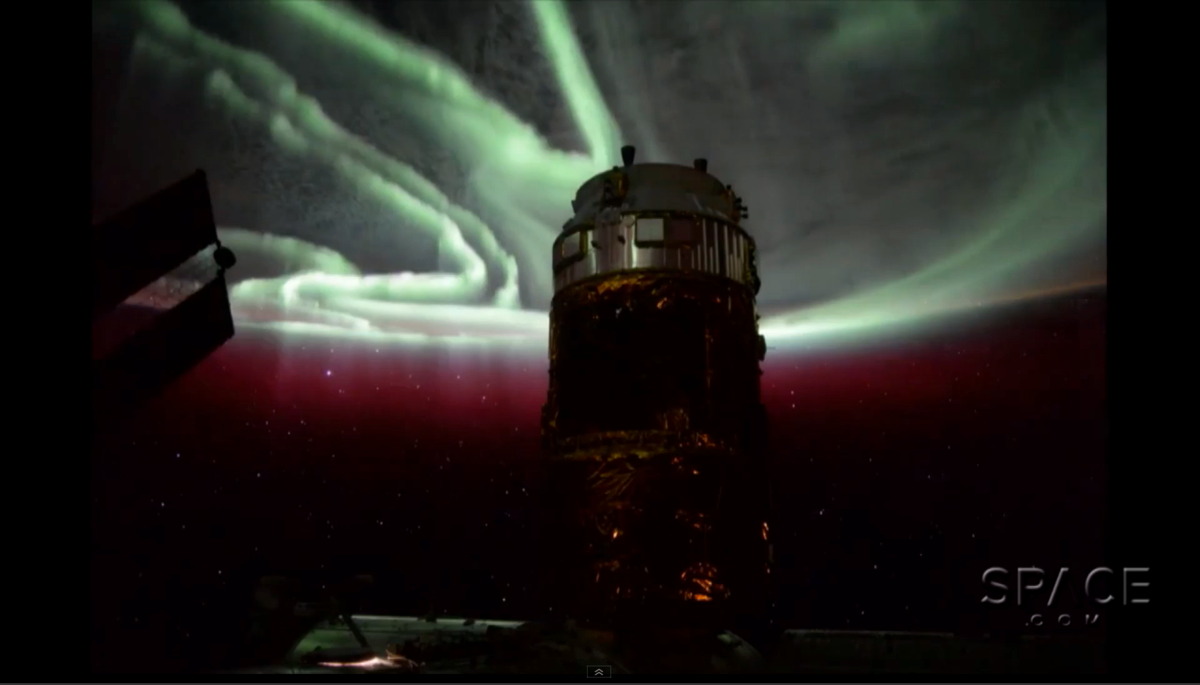Wow! Space Station Astronauts Awed by Dazzling Auroras (Video)

Earth's natural light show — the auroras — flared into high gear Monday (Sep. 7), creating a breathtaking display that astronaut Scott Kelly said was like no other aurora he'd ever seen.
Bright-green rivers of light and a deep-crimson haze decorated Earth's atmosphere during the Labor Day light show. From his vantage point on the International Space Station, Kelly caught several snapshots of the waving green lights, as well as a vivid time-lapse video.
"I would say yesterday was probably the second-most impressive thing I've ever seen," Kelly said in an interview broadcast today (Sep. 8) on NASA TV. "The first thing was when I saw Earth from space the first time." [Amazing Auroras: Breathtaking Northern Lights Photos of 2015]
Kelly posted several photos of the waving green lights on Twitter, and included a time-lapse video of the lights' movement, writing that it was a Labor Day gift to the United States.
In the interview, Kelly was joined by the other eight people currently living on the orbiting laboratory as he discussed the unbelievable natural fireworks.
"Yesterday, we had some incredible auroras outside, like none I've ever seen before with regards to how vivid it was," Kelly said during the interview. "We had heard a solar storm was on its way, and usually, we think it takes a couple of days from solar activity to an incredible show outside. But in this case, it was much faster, and the Earth responded much quicker."
Skywatchers at high northern latitudes of Earth were able to see the auroras as well. Sightings were reported from Alaska, parts of Canada, southern Norway and Sweden, and as far south as Maine, Massachusetts, Minnesota and Wisconsin.
Breaking space news, the latest updates on rocket launches, skywatching events and more!
The Labor Day auroras began when a geomagnetic storm engulfed the Earth, according to Spaceweather.com. Geomagnetic storms are caused by flurries of energetic, charged particles released by the sun. This storm was only of moderate strength — a G2 on a scale that goes up to G5. A G2 storm can cause minor problems for satellites in orbit and power grids on Earth (whereas stronger storms can damage these systems severely). Nonetheless, this "moderate" storm created a spectacular auroral display.
Editor's note: If you have an amazing photo of Monday's aurora or any other night-sky view you'd like to share for a possible story or image gallery, please contact managing editor Tariq Malik at spacephotos@space.com.
Email Sarah Lewin at slewin@space.com or follow her @SarahExplains. Follow us @Spacedotcom, Facebook and Google+. Original article on Space.com.
Join our Space Forums to keep talking space on the latest missions, night sky and more! And if you have a news tip, correction or comment, let us know at: community@space.com.

Sarah Lewin started writing for Space.com in June of 2015 as a Staff Writer and became Associate Editor in 2019 . Her work has been featured by Scientific American, IEEE Spectrum, Quanta Magazine, Wired, The Scientist, Science Friday and WGBH's Inside NOVA. Sarah has an MA from NYU's Science, Health and Environmental Reporting Program and an AB in mathematics from Brown University. When not writing, reading or thinking about space, Sarah enjoys musical theatre and mathematical papercraft. She is currently Assistant News Editor at Scientific American. You can follow her on Twitter @SarahExplains.
